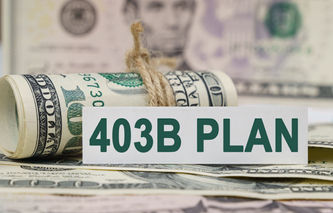For anyone that's been wondering whether or not to fund a Roth IRA or a 403(b) plan, we're going to lay out some of the factors to consider before making that decision. They are both great retirement planning options, but there may be reasons for choosing to fund one type of plan versus the other.
We're going to start off by stating that individuals with enough disposable income shouldn't even be thinking about whether or not funding a Roth IRA versus a 403(b) plan is a better decision. They should fund both. Those that can only afford to fund one account type should keep on reading.
Benefits of Roth IRA Plans
The biggest benefit of a Roth IRA plan is the fact money withdrawn from the account at retirement is free from federal income taxes. For example, if someone decides to place $5,000 into a Roth IRA in 2021, and that grows to $15,000 at retirement, they can withdraw all $15,000, and do not have to pay any federal income taxes.
Another benefit a Roth IRA offers is greater access to the money in the account. While the Roth IRA withdrawal rules may be restrictive with respect to withdrawals that can be made without incurring a penalty, accountholders still have the right to remove the money from the account at any time. Just keep in mind that an early withdrawal penalty may apply.
Note: There are some more downsides to a Roth IRA that you should be aware of - make sure to visit our guide before making any decisions.
With 403(b) plans, accountholders will need to consult with their plan administrator concerning the early withdrawal rules. Money can be loaned from a 403(b), but it is paid back with interest. (Some people might consider the fact it's harder to get to their retirement money a benefit.) Individuals may not be able to contribute to their 403(b) until the loan is repaid.
Employer Matching and Taxes
Perhaps the biggest advantage of a 403(b) plan versus a Roth IRA is the fact employers often match employee contributions. These matching contributions can quickly and greatly enhance the overall value of a 403(b) account.
Another benefit of employer plans such as a 403(b) is the money that goes into the account is done so on a before-tax basis. With a Roth IRA, the money used to fund the account is on an after-tax basis. Let's look at a quick example to see the difference this can make in the value of the fund.
Roth IRA versus 403(b) Plan Example
In this example, let's assume that Bill is planning to contribute $5,500 to his 403(b) plan, and his employer matches contributions at a rate of $0.50 for every dollar he contributes. Alternatively, Bill could use this $5,500 in income to fund a Roth IRA. Let's also assume that he is in the 28% federal income tax bracket.
Roth IRA versus 403(b) Account Value
Roth IRA | 403(b) Plan | |
Pre-Tax Income | $5,500 | $5,500 |
Taxes Owed | $1,540 | $0 |
Employee Contribution | $3,960 | $5,500 |
Employer Match | $0 | $2,750 |
Total Account Value | $3,960 | $8,250 |
The above table demonstrates how much more money Bill will have in his 403(b) plan versus a Roth IRA. Now some might be quick to point out that when the money is withdrawn from the 403(b) plan federal income taxes need to be paid. Let's continue with this example to see how works out.
Let's say Bill won't need this money for 15 years, and it's going to grow at 7.0% per year. At the end of the 15th year, he will have $10,926 of tax-free money in the Roth IRA account. The money placed in the 403(b) plan will be worth $22,762. After paying taxes of $6,373, there will still be $16,389, or $5,463 more after-tax money to spend from the 403(b) investment.
This is the reason why so many financial consultants recommend clients first fund their employer sponsored retirement savings plans up to the point that employer matching stops.
Retirement Investment Options
In the past, 401(k) plans and 403(b) accounts offered investors limited flexibility when it came to investment options. For example, participants might be limited to three to five mutual fund offerings. Although these funds usually provided relatively low returns, they were often very safe investments; thereby preserving capitalduring a bear market.
Most plan administrators now offer more flexibility to their employees such as Schwab's Personal Choice Retirement Account, or PCRA. These types of accounts can be used by 403(b) plan participants to greatly expand their investment options, and are nearly identical to other investment accounts used for retirement.
Bankruptcy Protection
Finally, federal laws are strong when it comes to protecting retirement plans such as 403(b) accounts from creditors in the event of bankruptcy. But the money placed into an IRA account is a completely different matter.
The exact amount of protection provided to IRA account owners depends on state law. Sometimes states provide no protection at all for IRAs, while others might provide limited protection. Anyone that thinks they might file for bankruptcy should research their state's protection policies before choosing between a Roth IRA and a 403(b).



